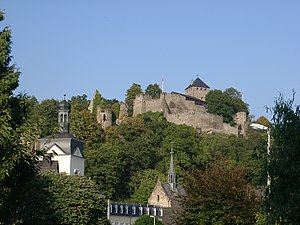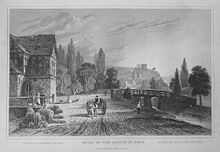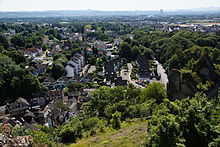Sayn Castle
| Sayn Castle | ||
|---|---|---|
|
Kehrberg with castle ruins, in the foreground the baroque tower and chapel of Sayn Castle |
||
| Creation time : | from 1152/1192 | |
| Castle type : | Höhenburg, spur location | |
| Conservation status: | ruin | |
| Standing position : | Count | |
| Construction: | Cuboid, quarry stone | |
| Place: | Bendorf | |
| Geographical location | 50 ° 26 '20.4 " N , 7 ° 34' 45.5" E | |
| Height: | 110 m above sea level NHN | |
|
|
||
The ruins of Sayn Castle , the ancestral castle of the Counts of Sayn and Sayn-Wittgenstein , built in the 12th century , is located in the Sayn district of Bendorf am Rhein between Koblenz and Neuwied in the Mayen-Koblenz district in Rhineland-Palatinate .
location
The ruin of the Spornburg rises on the approximately 110 meter long and 40 meter wide ridge of the Kehrberg, a foothill of the Westerwald , between the valley cuts of Brexbach and Saynbach . Below the ruins, the town of Sayn extends to the south and west, with Sayn Castle at the foot of the castle hill , a former baroque building from 1757, which was changed in the neo-Gothic style in the nineteenth century.
Between Schloss Sayn and Burg Sayn there are two former burgers' seats , the middle castle house from the 15th century , which is connected to the castle by a wall, and the von Steinschen Sitz ( Castle Stein ) of the Lords of Stein from Nassau from the 14th century. About 600 m further east, a predecessor to Sayn Castle stood on the ridge, the old castle from the 10th or 11th century, of which sparse remains of the foundations have been preserved.
Sayn Castle can be reached via federal road 413 and state road 306 which turns off in Sayn. There is a larger parking lot at the castle, another one directly in front of the castle wall.
The Rheinsteig and Saynsteig hiking trails run right across the site .
history
For the first time in the 10th century, the Counts of Sayn were mentioned in a document in connection with the Count Palatine in Auelgau , whose sub- counts they were probably. Heinrich I and his brother Eberhard I von Sayn, who resided in the old castle , also known as Eselsburg , are said to have acquired the county of Bonn through marriage between 1139 and 1150. This led to violent disputes with the Archdiocese of Cologne , in the course of which their castle was at least partially destroyed in 1152, so that they retired to Blankenberg Castle (Sieg) .
The construction of a new castle on the western spur of the Kehrberg began immediately afterwards. Count Heinrich III. (the great) von Sayn and his wife Mechthild von Meißen-Landsberg ruled from the new castle in the first half of the 13th century, a county stretching from the Lahn to the Cologne-Bonn area with possessions on the central Moselle and in the Westerwald . Henry III. died childless in 1247.
Sayn Castle and its county fell to Count Johann I von Sponheim , the son of his sister Adelheid, whose descendants in turn called themselves Counts von Sayn. They ruled the county from their Westerwald residences in Sayn , Hachenburg , Altenkirchen and Friedewald . In 1345 the County of Wittgenstein also came to Sayn through marriage . This line was then called Sayn-Wittgenstein from 1361 .
In 1606 Heinrich IV. Von Sayn died without leaving a male successor. Sayn Castle was destroyed by the Swedes only a few years later in 1632 during the Thirty Years War . The now uninhabitable ruins came to the Electorate of Trier in 1652 together with the Sayn office , to which the towns of Sayn , Mülhofen and Stromberg belonged, and remained there until the beginning of the 19th century.
Prince Friedrich Wilhelm von Nassau-Weilburg, who was married to Hereditary Countess Luise Isabella von Sayn-Hachenburg, came into possession of the castle ruins in 1803, only to have to cede them to Prussia as part of the Rhine Province in 1815 through the resolutions of the Congress of Vienna .
The castle ruins and palace came back into the Sayner's possession in 1848 through a gift from the Prussian King Friedrich Wilhelm IV. To Prince Ludwig zu Sayn-Wittgenstein-Berleburg , who had just returned from Russia with high honors , who immediately had the palace rebuilt in a neo-Gothic style, moved there and henceforth called to Sayn-Wittgenstein-Sayn . Sayn Castle continued to exist as a ruin, the building stock of which was secured and partially expanded between 1981 and 1987 under the current owner, Prince Alexander of Sayn-Wittgenstein-Sayn .
Castle complex
While the southern, western and northern flanks of Sayn Castle slope steeply down to the valley, the flat ridge on the eastern side of the access is secured by an artificially created deep and wide neck ditch . For reasons of additional protection, a mighty shield wall rises above the trench , which is provided with a battlement . In the north-eastern area of the complex is the well-preserved, approximately 20-meter-high keep , which dominates the appearance of Sayn Castle. The construction time of the brickwork, which is 2.40 meters thick, dates back to the late 12th century. A wall that runs south from the keep and is also reinforced by a corridor divides the core castle into two courtyards.
Excavations in recent times lead to the conclusion that on the south side of the smaller eastern court initially the palace stood, which was later moved to the western spur of the plant, but up to a 25 meter deep well and an octagonal today stair tower no longer exists. These excavations also unearthed the foundation walls of the castle chapel in the south-western corner in the form of a double church with three apses and its well-preserved, very beautiful ornamental floor from around 1200.
In front of the southern curtain wall is a 90 meter long and 20 meter wide kennel , which is bordered to the east by a fortified tower and to the west by a barbacane . There is also a smaller gate kennel and further down the slope the middle castle house , which is connected to the main castle by a wall in a westerly direction. The excavations carried out by the State Office for Land Monument Preservation also exposed the original access route to the core castle along the southern flank through the gate kennel, which has been accessible again since then.
use
As part of the restoration work carried out in 1981–1987, a wildlife park encompassing the entire complex was created and stocked with red deer , fallow deer and mouflon . Above all, the animals should prevent the system from overgrowing again. The wildlife park was abandoned after a few years, only the falconry is still operated seasonally. Until 2009, flying demonstrations by the Falconry Castle Sayn took place halfway between the castle and the core castle above .
For tourist reasons, a castle tavern was built between the shield wall and another upstream wall in 1986–1987. An old door opening and consoles for ceiling beams indicated that a building used to stand there too. The DieSayn Burg restaurant , a new building with a terrace and an old vaulted cellar underneath, is largely hidden behind the existing ruins and therefore does not dominate the overall appearance of the complex.
The keep was also given a new use in 1987 after it had been restored and given a new roof hood. Two holiday apartments were set up on the upper floors.
literature
- Dehio : Rhineland-Palatinate, Saarland . Munich 1984, pp. 92-93
- Udo Liessem: On the building history of Sayn Castle. In: Alexander Prince of Sayn-Wittgenstein-Sayn (ed.): Sayn - place and royal house. o. O., o. J. (Bendorf-Sayn 1979)
- Alexander Thon, Stefan Ulrich: "... like a monarch enthroned in the middle of his court". Castles on the Lower Middle Rhine . Schnell & Steiner, Regensburg 2010, ISBN 978-3-7954-2210-3 , pp. 142-147.
Web links
- Entry on Castle Sayn I: Alte Burg, Eselsburg, Riesenkammer in the scientific database " EBIDAT " of the European Castle Institute
- Entry on Castle Sayn II: Castle Sayn, Castle on the Kehrberg in the scientific database " EBIDAT " of the European Castle Institute
- Entry on Castle Sayn III: Middle castle house in the scientific database " EBIDAT " of the European Castle Institute
- Entry on Castle Sayn IV: Steinsches Burghaus, Kaff in the scientific database " EBIDAT " of the European Castle Institute
- Sayn Castle
- Further information on the castle history
- History of Sayn Castle
- Reconstruction drawing in the medieval state
Individual evidence
- ↑ Wilhelm von der Nahmer: Handbuch des Rheinischen Particular-Rechts: Development of the territorial and constitutional relations of the German states on both banks of the Rhine: from the first beginning of the French Revolution up to the most recent times . tape 3 . Sauerländer, Frankfurt am Main 1832, p. 615 ( online at Google Books ).








